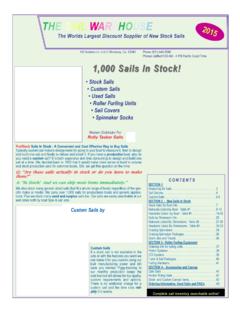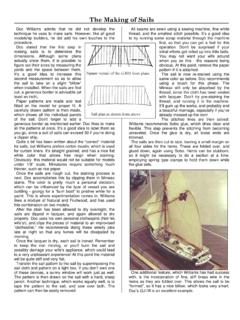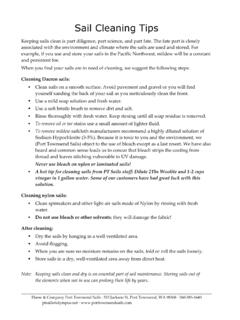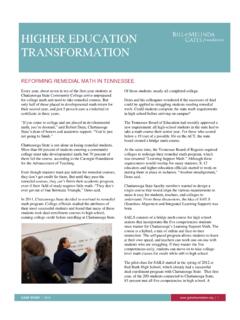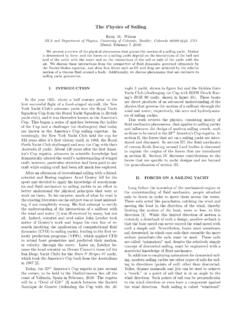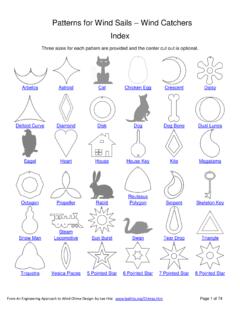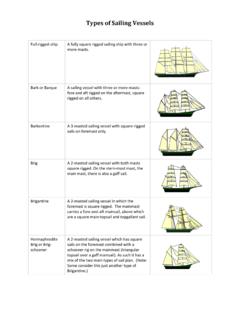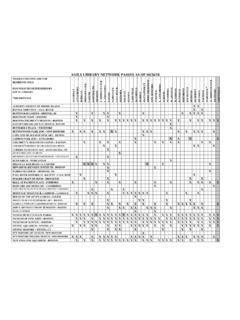Transcription of Measuring For Mainsails: Measuring For Headsails ...
1 Measuring For Mainsails: LuffHook your tapemeasure up tothe main halyard (along with the head of theold mainsail if available). Hoist it under nor-mal luff tension. If your old sail is not avail-able then hoist to the maximum height youwant your mainsail to stretch up to(better alittle short than too long). If there are bandson the mast, measure to the band. Thenmeasure down to the top surface of theboom itself. (Not the tack pin on the boom).This will be the LUFF (or P ).LeechWhile the tape meas-ure is still hoisted,swing it back to theaft end of the boom and measure (a straightline) to the point where you want your clewring to be located. This is the LEECH .FootLower the tape and attach it to the out haul linealong with the clew of your old mainsail if the out haul to the maximum point of measurement from there to the aft face of themast. (Not to the tack fitting on the boom). This will be the FOOT (or E dimension).If no old mainsail is available pull it out to where you want yourclew to stop.
2 (If there is a band on the boom, measure to it).Luff & Foot HardwareNote the shape and size ofthe slides, slugs, or boltrope and how they attachto the mast. These areeasily changed on main-sails but it is helpful toknow anyway. Flat internaland external slides aremeasured in width whilecylindrical slugs and bolt rope are measured in Pin SetbackDetermine thelocation of theTack Pin on yourboom goose-neck . This ismeasured in inches behind the mast andabove the boom and is used to locate the tackring on your mainsail in the right place so itdoesn t is not necessary for usedor stock sails since they are already fixed. Youcan add shackles or lashings if needed to smooth it out. Measuring For Headsails :Max. LuffHook a long tape measureup to your jib halyard (ortop furling swivel on a furlersee Furler Hoist below) just as if it were thehead ring of the sail. Hoist it all the wayuntil it stops at the top. Measure down towhatever point you intend to attach thesails tack to.
3 This will be your MAX. HOIST . Be conser-vative when ordering and allow afew inches for stretch or error. J DimensionMeasure the horizontal dis-tance between the tack fit-ting and the mast. This isthe J dimension andwill be the number the L/P is compared tofor percent Lead AngleBe sure that the clew height for the jib or genoa youwant will allow you to sheet to the existing genoatrack or you may need to add additional an imaginary line from about mid luffthrough the clew to the deck. When the sail issheeted in flat you should be able to achieve eventension both down the leech and back on the you will end up with a sail that is Strapped (tight) along one and loose on the in doubt we recommend you mock up the sailusing line or tape measures and test the lead out. Furling SailsIf you have a furling unit, hook thetape measure up to the upper furlingswivel(as if it were the head of thesail). Hoist the tape all the way upand measure down to the tack fittingon the furling determinethe diameter of the luff tape needed.
4 (Luff tape isthe small bead that feeds into the headfoil).Thiscan be measured on an old sail with calipers ora fine scale ruler. Luff tape size is provided withfurling unit documentation too. The most com-mon size is #6 (measures slightly over 3/16. )SpinnakersFor racing, the spinnakers luff should equal the I dimension and the max foot/girth should notexceed X J .For cruising spinnakers the luff can be plus orminus 8% of I but cannot exceed maximumhoist on the halyard. Spinnaker foot should fallbetween and X J Download and print this page to organize your measurements. For customsails, follow all of the steps and be detailed and spe-cific about your requirements including hardware and tack pin set back. For stocksails focus on the basics; dimensions, clothweight, and luff types on Headsails . Then perform a search by luff length leaving boat type Unspecified . Aclose fit is good but anexact fit is not necessary. Measure according to the instructions below and fill in the boxes.
5 Please be conservative when orderingand allow a few inches for stretch or short is fine but too long can be a PinTack Pin Set ( P ) ( E )4. (circle typebelow and fillin size here) :Foot:Luff:1. Max. LuffFurlerHoist2. LeechTo Figure % OverlapMultiply the boat s J dimen-sion times the headsail per-cent you want. That shouldbe equal to the sail si sthe length of a line drawnfrom the clew to the luff, inter-secting the luff at 90degrees.) If your J is 10 feetand you want a 150% the L/Pmust equal 15 Furler LuffTape size3. Foot ( E ) I 2. J 2. J Genoa TrackBehindmast:Foretriangle a PDFS lugsand Bolt RopeInternal slidewidthSlug and boltropediameterExternal slidewidthMainsail Diagram
